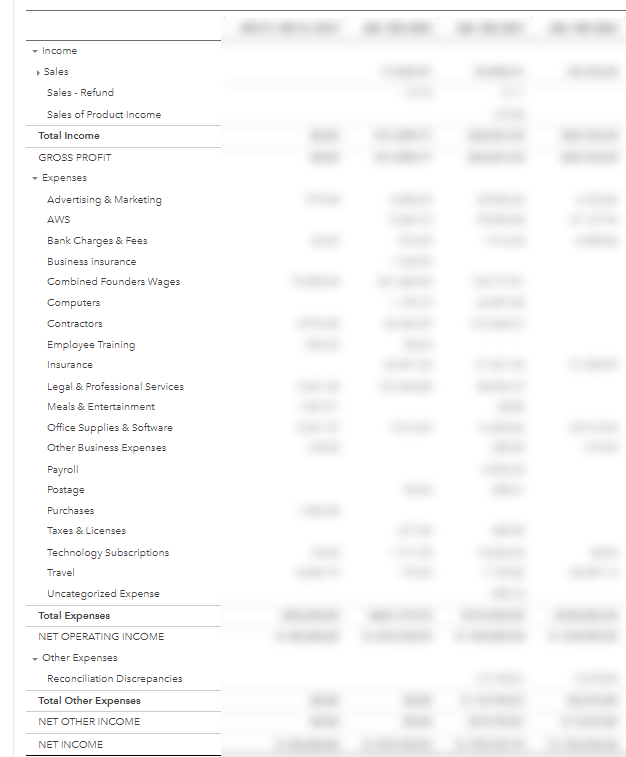QuickBooks Online Infrastructure: Does Your Accountant Know What They’re Doing?
How to set up QBO for startups
If you’re like most founders, when the first investment money hit your bank account you started looking for an accountant who could file your taxes (ok, maybe you started looking on April 14th the following year). You probably picked the one who gave you the lowest rate to file taxes and they set up QuickBooks Online (QBO) for you. Statistically, there’s a strong chance they aren’t very experienced with startups.
Most of the time when we open a potential client’s QBO it looks something like this. A bunch of out of the box accounts, without any account codes, organized in the default alphabetical order, and with no hierarchical structure.
If your books look like this^ fire your accountant.
Organizing your P&L General Ledger Codes
As we discussed in our forecasting post, it’s critically important to organize your Chart of Accounts (CoA) into an easily readable structure that investors and key stakeholders are expecting to see. By using account codes to make a hierarchy, and nesting accounts under key parent accounts like: Revenue, Direct COGS, R&D expenses, Sales and Marketing expenses, and G&A expenses, you can make a P&L that is easily collapsible to a management level review, and shows key stats like revenue, gross profit, operating profit, and net income at a glance.
Depending on whether or not you have government grants and contracts, need heavy facility costs to operate (E.G.manufacturing), or are a more standard B2B SaaS company, the number of accounts and the headers you have can look slightly different, but you should always split out revenue types, COGS, R&D, and SG&A at a minimum.
See below for a collapsed P&L example for a Deep Tech hardware company that does heavy government work.
Organizing your Balance Sheet General Ledger Codes
Balance sheet structure is generally less varied across clients than the P&L, but it is important to organize your assets, liabilities, and equity sections into the right hierarchy. If you have major assets (250k+) you probably want an accumulated depreciation account under each one. You need to have interest on any convertible debt and it should be included as a sub-account to the liability. Your equity section needs to actually reflect the type of structure you are. You should not have “owner’s investment” if you are a Delaware C organization (and if you are a startup, you should be a Delaware C). Equity should be split into common and preferred stock, and also split between the par value account and your Additional Paid In Capital (APIC).
Us 95% of the time when we see a balance sheet:
It’s important to get this right early, because you can never really “delete” things in QBO, you can only “inactivate” them, and sloppy organization early on will leave ghost accounts that can jam up integrations and historic reporting.
Organizing Classes, Customers, and Locations
One of the other big mistakes we frequently see is founders (or sometimes accounting teams!) trying to use the Chart of Accounts to track project or customer data. E.G. “NSF Phase I Direct Costs” as a parent account, with labor, materials, contractors, etc underneath.
This is a huge mistake because it will jam up your chart of accounts (imagine what it looks like when you have 20 projects going on at once), and it makes it harder to do reporting.
There are four main variables that you can use to slice and dice data in QBO:
GL code
These are the accounts under the chart of accounts
Products and services for invoices will map to these accounts
Customer
All revenue and COGS should be assigned to a customer! Note you can have “sub-customers” or projects under a customer
Class
This is usually either a department or a product line
These can be turned on and off in settings
Location
This can be named many things, but it can be physical locations, departments, product lines etc.
These can be turned on and off in settings
Note: You can put classes on multiple lines of a transaction, however “location” can only be used at the top level. E.G. You could have a journal entry, invoice, or bill with three lines, each with a different class (marketing, engineering, and product), but you can only have 1 location per Bill, Invoice, Journal Entry, which makes classes a little more robust and flexible.
Most companies can get away with just using a good CoA, Customer, and Class infrastructure for quite some time. For those just starting out with Government grants and contracts our preferred structure is
01_Admin, 02_Commercial, 03_Government
This allows you to run P&Ls for government and commercial work to differentiate profit margins, while understanding what your overhead costs are. You can also filter for government or commercial work and then split a P&L by customer, so if gross margin looks low or high for a business unit or product line you can dive in and see customer by customer who is throwing the variance.
Why should you care?
It does generally cost more to organize your data with this level of precision, but there are so many tools (like ramp!) that make this a significantly lower lift than it used to be (see what some of our clients think about what we’ve done with ramp here.) If you are planning on doing government grants and contracts like SBIRs you’ll have to do this anyway, and it costs more to clean it up than to just do it right in the first place.
At the end of the day if your accountant is more concerned about whether cash reconciles than understanding how your business is operating and why, they aren’t a good fit for startups. The Ibex team has done 50+ QBO setups and cleanups for high-growth tech startups and that number is growing by the week. Reach out if you’d like help!







